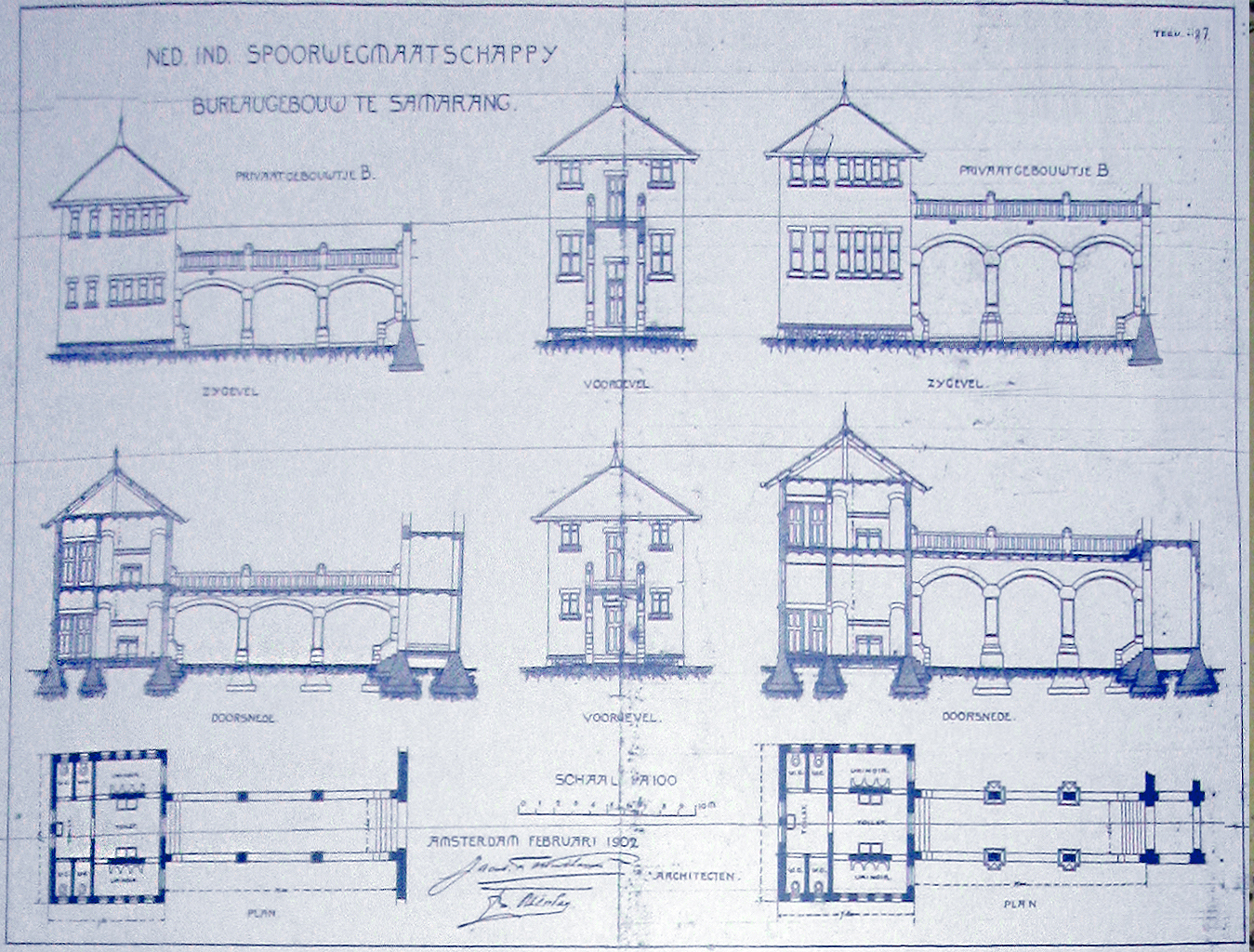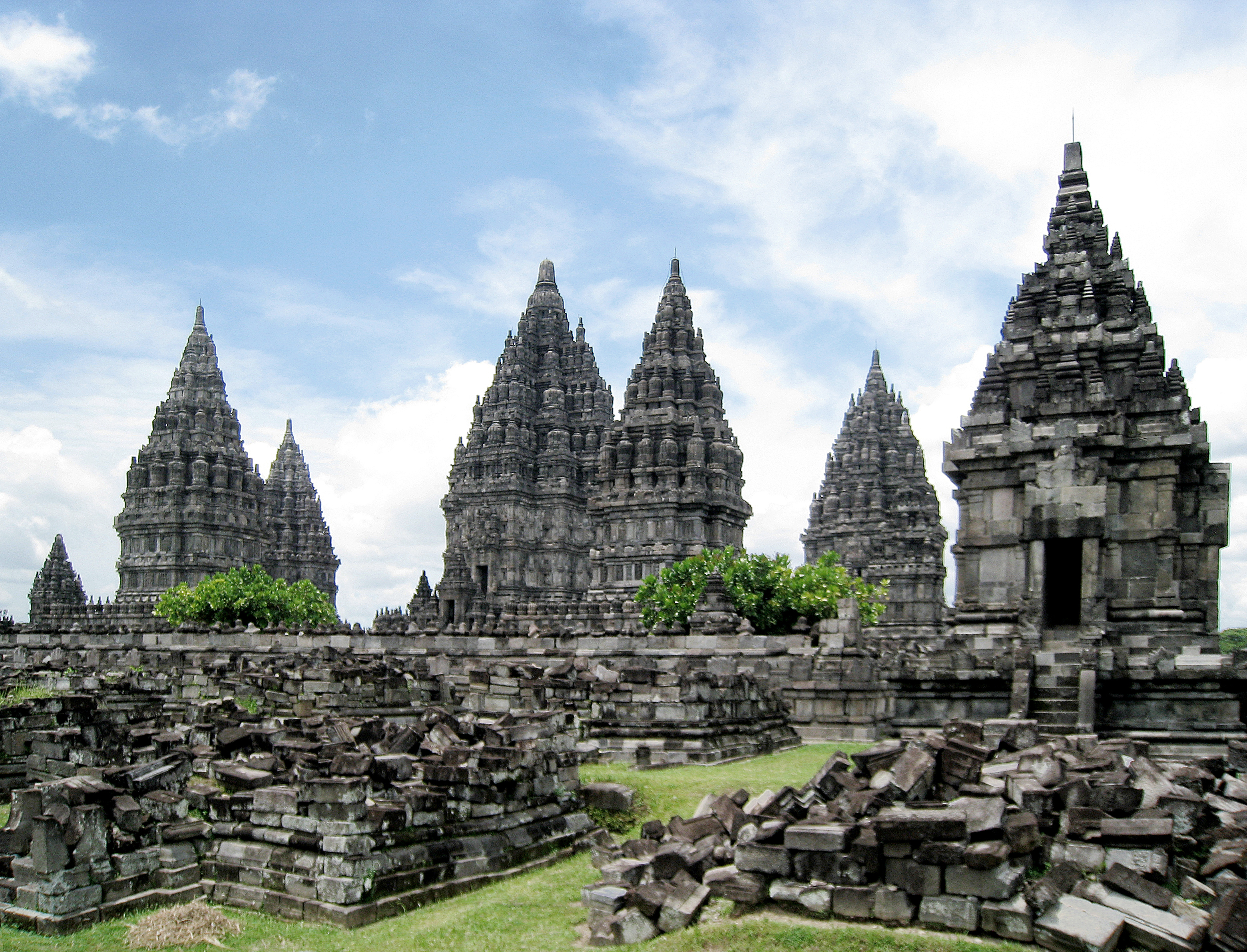|
Lawang Sewu
''Lawang Sewu'' () is a former office building in Semarang, Central Java, Indonesia. It was a head office of the Dutch East Indies Railway Co. (Nederlandsch-Indische Spoorweg Maatschappij/NIS) and is owned by the national railway company Kereta Api Indonesia (KAI). Its predecessor, Djawatan Kereta Api, was seized every rail transport infrastructures and offices from Dutch occupation. Today the building is used as a museum and heritage railway gallery, currently operated by Heritage Unit of KAI and its subsidiary KAI Wisata. Etymology The Javanese word ''lawang sewu'' is a nickname for the building, which means "a thousand doors". The name comes from its design, with numerous doors and arcs. The building has about 600 large windows. Layout The complex consists of several buildings, two main ones named A and B and two smaller ones named C and D, on Pemuda Street. The L-shaped A building faces the Tugu Muda roundabout. There are two identical towers on A building, which were origin ... [...More Info...] [...Related Items...] OR: [Wikipedia] [Google] [Baidu] |
Semarang
Semarang ( jv, ꦏꦸꦛꦯꦼꦩꦫꦁ , Pegon: سماراڠ) is the capital and largest city of Central Java province in Indonesia. It was a major port during the Dutch colonial era, and is still an important regional center and port today. The city has been named as the cleanest tourist destination in Southeast Asia by the ASEAN Clean Tourist City Standard (ACTCS) for 2020–2022. It has an area of and is located at . The population of the city was 1,555,984 at the 2010 censusBiro Pusat Statistik, Jakarta, 2011. and 1,653,524 at the 2020 census,Badan Pusat Statistik, Jakarta, 2021. making it Indonesia's ninth most populous city after Jakarta, Surabaya, Bekasi, Bandung, Medan, Depok, Tangerang and Palembang. The built-up urban area had 3,183,516 inhabitants at the 2010 census spread over two cities and 26 districts. The Semarang metropolitan area (a.k.a. ''Kedungsepur'') has a population of over 6 million in 2020 (''see Greater Semarang section''). The population of the cit ... [...More Info...] [...Related Items...] OR: [Wikipedia] [Google] [Baidu] |
Dutch East Indies
The Dutch East Indies, also known as the Netherlands East Indies ( nl, Nederlands(ch)-Indië; ), was a Dutch colony consisting of what is now Indonesia. It was formed from the nationalised trading posts of the Dutch East India Company, which came under the administration of the Dutch government in 1800. During the 19th century, the Dutch possessions and hegemony expanded, reaching the greatest territorial extent in the early 20th century. The Dutch East Indies was one of the most valuable colonies under European rule, and contributed to Dutch global prominence in spice and cash crop trade in the 19th to early 20th centuries. The colonial social order was based on rigid racial and social structures with a Dutch elite living separate from but linked to their native subjects. The term ''Indonesia'' came into use for the geographical location after 1880. In the early 20th century, local intellectuals began developing the concept of Indonesia as a nation state, and set the stage ... [...More Info...] [...Related Items...] OR: [Wikipedia] [Google] [Baidu] |
Landmarks In Indonesia
A landmark is a recognizable natural or artificial feature used for navigation, a feature that stands out from its near environment and is often visible from long distances. In modern use, the term can also be applied to smaller structures or features, that have become local or national symbols. Etymology In old English the word ''landmearc'' (from ''land'' + ''mearc'' (mark)) was used to describe a boundary marker, an "object set up to mark the boundaries of a kingdom, estate, etc.". Starting from approx. 1560, this understanding of landmark was replaced by a more general one. A landmark became a "conspicuous object in a landscape". A ''landmark'' literally meant a geographic feature used by explorers and others to find their way back or through an area. For example, the Table Mountain near Cape Town, South Africa is used as the landmark to help sailors to navigate around southern tip of Africa during the Age of Exploration. Artificial structures are also sometimes built to a ... [...More Info...] [...Related Items...] OR: [Wikipedia] [Google] [Baidu] |
Urban Legend
An urban legend (sometimes contemporary legend, modern legend, urban myth, or urban tale) is a genre of folklore comprising stories or fallacious claims circulated as true, especially as having happened to a "friend of a friend" or a family member, often with horrifying, humorous, or cautionary elements. These legends can be entertaining but often concern mysterious peril or troubling events, such as disappearances and strange objects or entities. Urban legends may confirm moral standards, reflect prejudices, or be a way to make sense of societal anxieties. Urban legends in the past were most often circulated orally, but now can also be spread by any media. This includes newspapers, mobile news apps, e-mail, and most often, social media. Some urban legends have passed through the years/decades with only minor changes, in where the time period takes place. Generic urban legends are often altered to suit regional variations, but the lesson or moral remains majorly the same. Or ... [...More Info...] [...Related Items...] OR: [Wikipedia] [Google] [Baidu] |
Basement Of Lawang Sewu 2011
A basement or cellar is one or more floors of a building that are completely or partly below the ground floor. It generally is used as a utility space for a building, where such items as the furnace, water heater, breaker panel or fuse box, car park, and air-conditioning system are located; so also are amenities such as the electrical system and cable television distribution point. In cities with high property prices, such as London, basements are often fitted out to a high standard and used as living space. In British English, the word ''basement'' is usually used for underground floors of, for example, department stores. The word is usually used with houses when the space below the ground floor is habitable, with windows and (usually) its own access. The word ''cellar'' applies to the whole underground level or to any large underground room. A ''subcellar'' is a cellar that lies further underneath. Purpose, geography, and history A basement can be used in almost exactly ... [...More Info...] [...Related Items...] OR: [Wikipedia] [Google] [Baidu] |
Ani Yudhoyono
Kristiani Herrawati Yudhoyono (6 July 1952 – 1 June 2019), more commonly known as Ani Yudhoyono, was an Indonesian political scientist, who was the wife of former Indonesian President Susilo Bambang Yudhoyono and First Lady of Indonesia from 2004 until 2014. Family and education Kristiani Herrawati was born on 6 July 1952 in Yogyakarta, to Lt. Gen. (ret.) Sarwo Edhie Wibowo and Sunarti Sri Hadiyah. She was the third child of seven siblings. In 1973, she became a medical student at the Christian University of Indonesia, but in the third year she followed her father who was appointed an ambassador to South Korea. She subsequently married Susilo Bambang Yudhoyono (SBY) in 1976. Ani later continued studying at Terbuka University and graduated with a bachelor's degree in political science in 1998. Career Yudhoyono's political activities included her appointment as vice chairman of the Democratic Party. She campaigned for the successful election of her husband for President of the ... [...More Info...] [...Related Items...] OR: [Wikipedia] [Google] [Baidu] |
Bibit Waluyo
Bibit Waluyo (born 5 August 1949) is an Indonesian politician and lieutenant general, who served as the governor of Central Java from 2008 until 2013, when he was defeated by Ganjar Pranowo. Prior to entering politics, he was an officer in the Indonesian Army, rising to the rank of lieutenant general and going on to hold the command of Kodam Jaya. Military career His military career began after graduating from the Army Military Academy in Magelang in 1972. Waluyo's career in the military field gradually began as a Combat Platoon Commander for Kodam II/Bukit Barisan (1973) with the rank of Second Lieutenant. Since then his career has continued to climb and he was given the trust to serve as Commander of the Infantry Battalion 407/Padma Kusuma (1986 - 1988) which successfully carried out operations in East Timor. https://m.merdeka.com/bibit-waluyo/profil/ He later served as Commander of Kostrad from 3 July 2002 to 3 November 2004. Political career Bibit Waluyo and Rustrining ... [...More Info...] [...Related Items...] OR: [Wikipedia] [Google] [Baidu] |
The Jakarta Post
''The Jakarta Post'' is a daily English-language newspaper in Indonesia. The paper is owned by PT Niskala Media Tenggara and based in the nation's capital, Jakarta. ''The Jakarta Post'' started as a collaboration between four Indonesian media at the urging of Information Minister Ali Murtopo and politician Jusuf Wanandi. After the first issue was printed on 25 April 1983, it spent several years with minimal advertisements and increasing circulation. After a change in chief editors in 1991, it began to take a more vocal pro-democracy point of view. The paper was one of the few Indonesian English-language dailies to survive the 1997 Asian financial crisis and currently has a circulation of about 40,000. ''The Jakarta Post'' also features an online edition and a weekend magazine supplement called J+. The newspaper is targeted at foreigners and educated Indonesians, although the middle-class Indonesian readership has increased. Noted for being a training ground for local and int ... [...More Info...] [...Related Items...] OR: [Wikipedia] [Google] [Baidu] |
Cultural Property Of Indonesia
Cultural properties of Indonesia are those items defined by Indonesian law as of "important value for history, science, and culture", and include both man-made artefacts and natural objects. The cultural properties number more than 8,000 and include ancient Hindu and Buddhist temples, mosques, historic colonial buildings, forts, art galleries, national parks and beaches. A number of the sites are World Heritage Sites. The current regime for the protection and promotion of the cultural properties of Indonesia ( id, benda cagar budaya) is governed by the Act of the Republic of Indonesia No. 5, 1992, concerning Items of Cultural Property. Such measures are to be understood against the background of Section 32 of the 1945 Constitution, according to which "The Government develops the National Culture of Indonesia". Regulation no. 10 of 1993 prescribes the registration of items of cultural property, which is to be undertaken by the relevant second level administrative area. As of ... [...More Info...] [...Related Items...] OR: [Wikipedia] [Google] [Baidu] |
PT Kereta Api
PT Kereta Api Indonesia (Persero) (English: Indonesian Railways Company, abbreviated as PT KAI or simply KAI) is the sole operator of public railways in Indonesia. It is completely state-owned and pays track access charges to the government. The headquarters of KAI are located in Bandung, West Java. History Kereta Api Indonesia is the latest of a long line of successive state railway companies dating from Dutch colonial days. Exactly on 27 August 1864, the first railway company in Indonesia was established by the Dutch colonial government as ''Nederlandsch-Indische Spoorweg Maatschappij'' (NIS) with Samarang-Tanggung as its maiden route. The first ground breaking was carried out in Kemijen Village and inaugurated by L.A.J.W. Baron Sloet van de Beele. Another railway company, ''Staatsspoorwegen'' was established, and their route stretched from Buitenzorg to Soerabaja. The Dutch colonial government also established '' Deli Spoorweg Maatschappij'' in North Sumatra, to transport ... [...More Info...] [...Related Items...] OR: [Wikipedia] [Google] [Baidu] |






